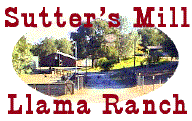 |
Llama Owner Information |
|
|
Transportation Sutter's Mill Llama Ranch Bill & Sandy Chickering (530) 642-2377 |
Llama Transport Llamas are easy to transport and require no specialized equipment. A covered windproof pickup, van, horse or utility trailer with sufficient room for animal(s) to stand comfortably works well. Good ventilation is important in both summer and winter. Straw makes excellent bedding in a windproof enclosure. Provide hay for food and offer water free choice every six hours depending on heat (it will spill if left with the animals). Llamas normally lie down once the vehicle starts moving. If transporting babies and mothers on long hauls, stop periodically to allow nursing. If your new llama is coming from out-of-state, check at least four weeks in advance to see if your state requires a veterinarian-issued health certificate. A permit number and/or tests for brucellosis, tuberculosis, and other diseases may also be required. Some states may require permanent identification markings on the animals. Full mortality and/or broad named peril (including transportation) insurance is available. |